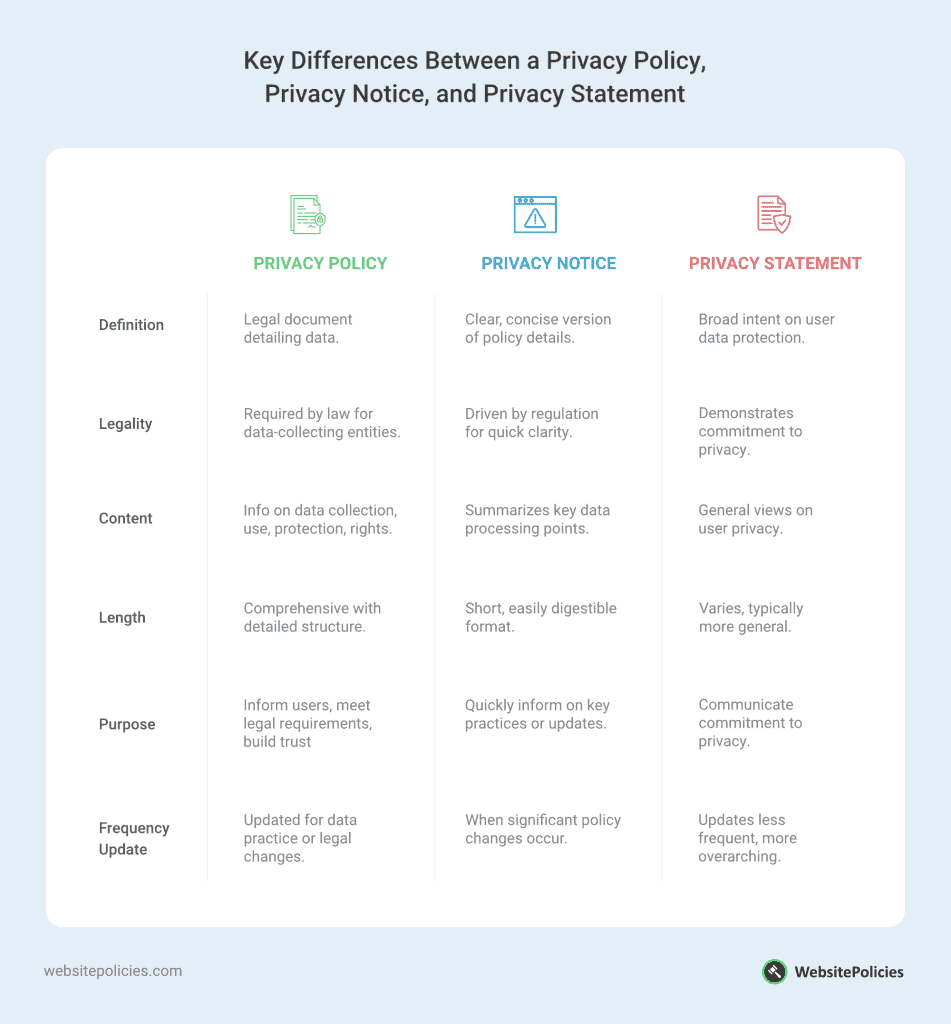When it comes to protecting consumer privacy, you have a responsibility to provide clear and transparent information about how personal data is handled. Three commonly used terms in this world of data privacy are privacy policy, privacy notice, and privacy statement.
Understanding the differences between these terms and knowing when and how to use each one can be critical for legal compliance and establishing trust with your users.
In this article, I will help you understand the distinctions and the purpose of each, so you will know which one to implement on your website or app.
I’ll also explore the best practices to ensure your practices align with the expectations and requirements of your users.
- A privacy policy informs users about data collection, usage, rights, and security, establishing trust and transparency.
- A privacy notice provides concise information at points where you collect data, which ensures awareness when it matters the most.
- A privacy statement serves as more of a public commitment to safeguard user privacy, which helps build accountability.
Table of Contents
PRO TIP: Take the hassle of writing your own privacy policy away with our privacy policy generator trusted by over 200,000 businesses. It’ll save you hours of work and possible costly legal mistakes.
What Is the Purpose of a Privacy Policy?
A privacy policy is a legally binding document that outlines how a company collects, uses, discloses, and manages a user’s personal data. It serves as a contract between the company and its users, making clear the types of information gathered, the reasons for collecting it, and the protections in place to safeguard that data.
In addition to providing clarity on how you collect and use consumer data, a privacy policy plays a key role in outlining data subjects’ rights and choices regarding their personal information. This includes informing them about their ability to access, modify, or delete their data, as well as the process for submitting requests related to data privacy.
Having a clear and transparent privacy policy is not just a legal necessity; it’s also a mark of respect towards your users. These days, people are becoming increasingly concerned about their online data.
By detailing your practices and intentions, you’re assuring users that their information is in responsible hands. This trust can significantly enhance your relationship with your audience, leading to increased loyalty and user engagement.
Moreover, a solid privacy policy can save you from potential legal pitfalls. Various jurisdictions, such as the European Union with its General Data Protection Regulation (GDPR) and California with its California Consumer Privacy Act (CCPA), have stringent rules about user data.
Non-compliance can result in hefty fines and reputational damage. I’ve seen businesses face backlash simply because they overlooked the importance of a well-crafted privacy policy.
PRO TIP: By ensuring you have a well-crafted privacy policy, you can protect your business from potential legal issues for failing to adhere to privacy laws.
What Should a Privacy Policy Include?
A privacy policy typically starts with an introduction or overview of the company and its general approach to data protection. From there, it details what personal information is collected, ranging from names and email addresses to more sensitive data like financial information or health details.
The policy should then explain how this information is used, such as for processing orders, personalizing user experiences, or marketing purposes.
An essential aspect of a privacy policy is detailing with whom the information might be shared. This could include third-party service providers, affiliates, or in scenarios like business mergers.
The policy should also describe the security measures in place to protect user data, as well as the rights users have regarding their data, such as the right to access, modify, or delete their personal information.
Lastly, the policy should mention its effective date, how often it’s updated, and how users will be notified of any significant changes.
Here’s a quick summary of the above:
- Overview of the company and data protection approach.
- Types of personal information collected.
- How the information is used.
- Parties with whom the data might be shared.
- Security measures to protect the data.
- User rights regarding their data.
- Effective date and update procedures.
PRO TIP: Your data handling policy should not be a dense legal document. Instead, it should be written in plain and accessible language that your audience can easily understand.
What Is the Purpose of a Privacy Notice?
A privacy notice is a short document that allows you to inform users about specific data processing activities in a clear and concise manner. Unlike the more detailed and comprehensive privacy policy, a privacy notice provides a snapshot of certain key elements related to data collection and use, making it more digestible for the average user.
The main aim of a privacy notice is transparency. When you collect data from users (or data subjects), whether it’s during a sign-up process, a purchase, or even just a site visit, you’re entering into a relationship with them.
This relationship is built on trust. By presenting a privacy notice, you’re openly sharing the what, why, and how of data collection, ensuring users are not left in the dark.
One of the standout features of a privacy notice is its timeliness. Let’s say you’re launching a new product or service, or perhaps you’ve updated your data collection practices.
Instead of directing users to sift through an extensive privacy policy, a privacy notice can be presented to quickly highlight these specific changes or points of interest. This way, users are immediately made aware of what’s relevant to them at that moment.
Legislation like the GDPR has raised the bar for transparency, emphasizing the need for clear communication with users regarding their data. In many instances, presenting a privacy notice isn’t just good practice; it’s a legal requirement.
When users see that you’re upfront about your data practices and are making efforts to keep them informed, their trust in your platform grows. So, while a privacy notice might seem like a small gesture, its impact on user trust and your company’s reputation can be profound.
If your information about how you collect data is unclear and not provided in a user-friendly manner, you can expect friction when your customers interact with your website or app.
What Should a Privacy Notice Include?
Rather than going deep into the details, as a privacy policy might, a privacy notice provides clear and direct information about particular data practices relevant at the time of interaction.
At its core, a privacy notice will describe the types of personal data being collected during a specific activity, such as signing up for a newsletter or making a purchase.
It then offers insight into why this data is being gathered — whether it’s for order fulfillment, communication, or another purpose. Furthermore, the notice will briefly touch on how the collected data will be used and stored.
Additionally, a privacy notice might mention any third parties involved in this specific data processing, giving users a heads-up about who else might have access to their information.
Users should also be informed about their rights in this context, such as the right to opt-out or request data deletion, even if in a summarized form.
Here’s a quick summary of the above:
- Types of data collected during an interaction.
- Purpose for collecting the data.
- How the data will be used and stored.
- Potential third parties involved in the data process.
- Brief mention of user rights for that specific interaction.
What is the Purpose of a Privacy Statement?
A privacy statement is a declaration that articulates a company’s stance and commitment to protecting the privacy of its users. While it shares similarities with a privacy policy and notice, its essence is more about conveying the overarching principles and values a company upholds concerning user data, rather than diving deep into specific operational details.
Think of a privacy statement as a pledge. When users interact with a platform, they often want assurance that their data is handled with care. The privacy statement provides this assurance, conveying to users that the company values their privacy and takes measures to protect their information.
This document is especially important in the age of data breaches and concerns over data misuse. I believe a robust privacy statement can serve as a strong foundation for a company’s reputation.
When users read a statement that resonates with their values and concerns about data protection, they’re more likely to feel a sense of trust and alignment with the brand.
Beyond trust-building, a privacy statement also offers a level of legal protection. By publicly stating the company’s commitment to privacy, it sets a standard that the company must adhere to.
It acts as a reminder, both to the users and the company itself, of the core principles guiding data-related actions and decisions.
What Should a Privacy Statement Include?
At its foundation, a privacy statement will often express the company’s dedication to safeguarding personal information and its intent to comply with prevailing privacy regulations.
It outlines the fundamental principles the company stands by when handling user data. This could be a commitment to data minimization, ensuring data accuracy, or transparency in data-related operations.
The statement may also briefly touch on the types of data the company values most, such as customer information or user preferences, and underscore the importance of protecting such data.
It’s also common for a privacy statement to highlight a commitment to ongoing review and improvement of privacy practices to ensure they remain robust and relevant.
Here’s a quick summary of the above:
- The company’s commitment to data protection.
- Fundamental principles guiding data practices.
- Types of data the company particularly values.
- An ongoing commitment to refining and enhancing privacy practices.
Key Differences Between a Privacy Policy, Notice, and Statement
Knowing the differences between a privacy policy, notice, and statement will help you follow privacy rules better and explain your privacy practices more efficiently.
Here’s a breakdown of the key differences between these documents in the table below:

Which One Should You Put On Your Website or App?
In my opinion, if you’re aiming for transparency and trustworthiness, incorporating all three elements — a privacy policy, notice, and statement — is the way to go. They complement each other, ensuring that your users feel both informed and respected.
If you’re running a website, especially one that collects any form of user data, you must have a privacy policy in place. Not only is this a display of transparency and integrity, but in many instances, it’s a legal necessity.
Take the GDPR or the CCPA, for example. Both of these require clear communication to users about data collection and usage. With a privacy policy, you’re not only shielding yourself from potential legal troubles but also demonstrating to your users that you’re upfront and transparent about how you handle personal information.
Now, while a privacy policy sets the stage, there are instances where more specific communication is necessary. That’s where a privacy notice comes in. If you decide to roll out a new feature or service that has unique data handling aspects, it’s more respectful to your users to offer them a direct heads-up.
A privacy notice can provide clear, concise information about this specific data practice, making it straightforward for users.
Lastly, a privacy statement speaks volumes about your values. Though it might not be laden with technicalities, it is your public commitment to honoring and safeguarding user privacy. It’s like giving your users a handshake, reassuring them that their data is in good hands.
Frequently Asked Questions
What is the purpose of a privacy policy?
A privacy policy outlines how you handle data practices and your user rights, building trust between your business and our users.
What should a privacy policy include?
It should describe the data types collected, how they’re used, user rights, security measures, and more.
What is the purpose of a privacy notice?
A privacy notice is a concise document at the point of data collection, which ensures users understand how you handle data before providing it.
What should a privacy notice include?
It should detail the types of data collected, usage, consent mechanisms, data storage, and contact details for privacy inquiries.
What is the purpose of a privacy statement?
A privacy statement declares your commitment to user privacy, establishes accountability and outlines data protection practices.
What should a privacy statement include?
It expresses dedication to privacy, summarizes data practices, adherence to privacy laws, data sharing safeguards, and contact information.
Which document should I use on my website or app?
Use all 3 if you can. A privacy policy is essential for all businesses, while a privacy notice adds transparency. A privacy statement reinforces your commitment to data protection.



